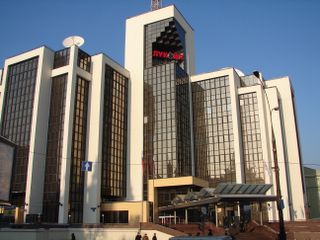On Second Thought ...
They say the next big thing is here
That the revolution's near
But to me it seems quite clear
That it's all just a little bit of history repeating
~Shirley Bassey
Yesterday, I posted two pictures on the blog. At lunch time today on the street near my office, I saw something that made me think of them all over again. It seemed to be the perfect amalgamation of the two types of symbolism, and reopened the topic for me.
Russia will probably continue to struggle with the appropriate balance between materialism and spirituality like, well, any human society that’s ever existed. But that, it seems to me, isn’t the real point of those two pictures. The real point is that those are examples of images, juxtaposed or not, that didn’t exist in Russia for most of the 20th century.
There is no conceivable theoretical need for “Sale” signs in a shop window in a centrally planned economy. After all, demand for products should always match supply. In practice, of course, there certainly wasn’t any need for such signs since the all the stores were empty.
In an officially atheist society that’s murderously hostile to religion, there’s not such a profusion of churches, either. For each charming, architecturally important church that wasn’t torn down, there are dozens more that were. Here in ‘Holy Moscow’, that means small monuments and plaques that inconspicuously mark where whole cathedrals and monasteries once stood.
It’s interesting to walk around on an early Sunday morning and see this legacy in human terms. In a park near the Garden Ring, a group gathers on the previous site of a church to conduct a small service. A half dozen folks gather around and sing hymns, with icons on artists easels and ornate Gospels on a tell lectern covered with brocaded altar cloth.
Just up the street from my apartment, a group gathers at the outside, eastern wall of a former nobleman’s mansion and conducts a similar service. That part of the wall is where the sanctuary of the family chapel was once located; once holy ground, in their opinion, always holy ground.
And that’s the real story behind the churches in both of those pictures. The one near the Mercedes symbol is the Cathedral of Christ the Savior – destroyed by Stalin in the 30’s and rebuilt again in all its mammoth opulence sixty years later. The church reflected in the shop window is a small chapel that marks the site of a destroyed church complex, now occupied by a massive soviet-era ministry.
So, in all, the fact that Russia can now struggle with the juxtaposition of conflicting symbols of materialism and spirituality is shocking, new, and the result of many generations of violent upheaval and struggle.
It’s really easy to forget about this recent history in Moscow. I routinely do just that as I flip through real estate listings of $1 million apartments and watch Bentleys zip down the boulevards.
That’s the Moscow that got me thinking about the photos once more. I snapped this picture a block or two from my office. I think it’s a suitable replacement for those photos. It’s the LUKoil headquarters, and probably as close to a “cathedral of commerce” that you can get in today’s Russia. No gold dome on top, but it has a $65 billion market cap.

Smells like oil - or money. Whatever. It's all the same these days.

It represents power, the promise of a better life, some measures of aspiration and some of inspiration. In short, it’s everything a good symbol of modern Russia should be.





0 Comments:
Post a Comment
<< Home